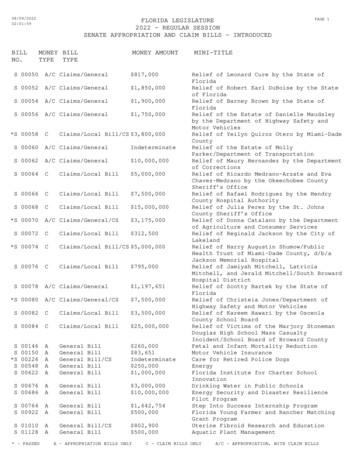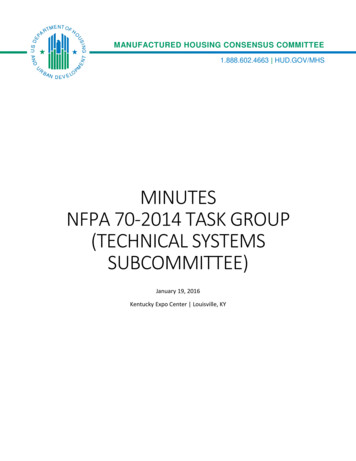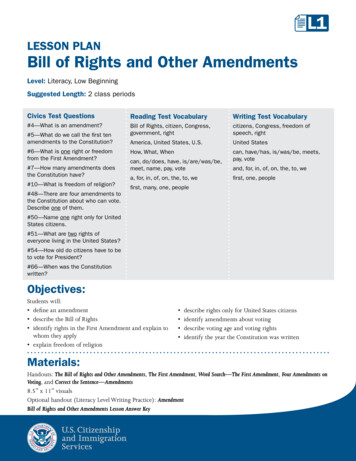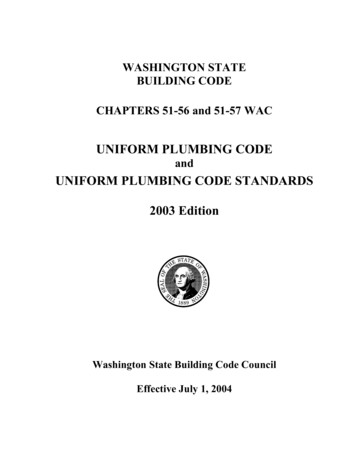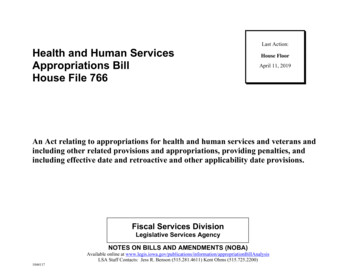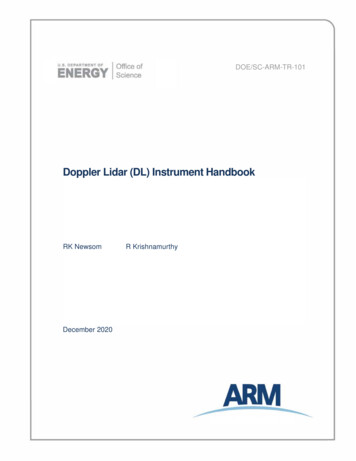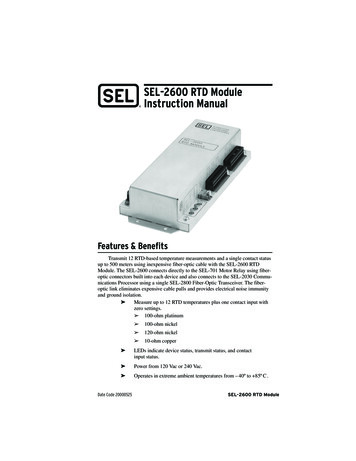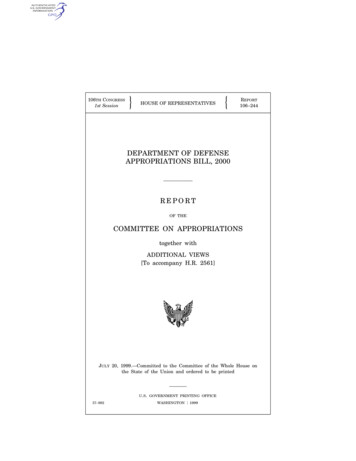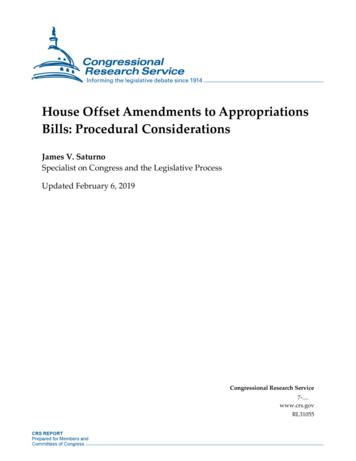
Transcription
House Offset Amendments to AppropriationsBills: Procedural ConsiderationsJames V. SaturnoSpecialist on Congress and the Legislative ProcessUpdated February 6, 2019Congressional Research Service7-.www.crs.govRL31055
House Offset Amendments to Appropriations Bills: Procedural ConsiderationsSummaryOne of the most common methods for changing spending priorities in appropriations bills on theHouse floor is through offset amendments. House offset amendments may generally changespending priorities in a pending appropriations measure by increasing spending for certainactivities (or creating spending for new activities not previously included in the bill) andoffsetting the increase with funding decreases in other activities in the bill. Offset amendmentsare needed to avoid points of order under Sections 302(f) and 311(a) of the Congressional BudgetAct, enforcing certain spending ceilings affecting regular appropriations bills, continuingresolutions (CRs), and supplemental appropriations measures (supplementals). In addition,amendments to general appropriations bills that would increase total spending provided in the billmust be entirely offset.Two types of House offset amendments are considered in the Committee of the Whole House onthe State of the Union (Committee of the Whole): clause 2(f) and reachback (or fetchback)amendments. As provided under House Rule XXI, clause 2(f) offset amendments consist of two ormore amendments considered together (or en bloc) that would change amounts by directly addingtext or changing text in the body of the bill. Taken as a whole, the amendment does not increasethe amount of funding in the pending bill. Such amendments (1) must provide offsets in both newbudget authority and outlays, (2) can only include language transferring appropriations in the bill,and (3) may contain certain unauthorized appropriations.Reachback offset amendments are generally offered at the end of the bill and change fundingamounts in the pending bill by reference. These amendments (1) must provide offsets in newbudget authority, but not necessarily outlays; (2) may add new appropriations (and spending setasides within certain restrictions); (3) cannot include unauthorized appropriations; and (4) mayprovide across-the-board spending reductions as offsets.Parliamentary rules governing consideration of offset amendments may be suspended or waived,typically by House adoption of a special rule but also by unanimous consent.The advantages of clause 2(f) amendments over reachback amendments are that clause 2(f)amendments may contain certain unauthorized appropriations and are typically considered beforereachback amendments, sometimes limiting offset opportunities for reachback amendments. Themain advantages of reachback amendments are that they may not have to offset outlays, may addnew appropriations, and may include across-the-board spending reductions.Congressional Research Service
House Offset Amendments to Appropriations Bills: Procedural ConsiderationsContentsIntroduction . 1Parliamentary Context . 2Spending Ceilings and Offset Amendments . 2Appropriations Measures: Selected Content . 3Lump-Sum and Line-Item Appropriations. 4Funding Set-Asides . 4Types of Offset Amendments . 5Clause 2(f) Offset Amendments . 5Must Offset Both Budget Authority and Outlays. 6Can Only Include Language Transferring Appropriations . 7May Contain Certain Unauthorized Appropriations . 8Exempt from a “Demand for a Division of the Question” . 9Reachback Offset Amendments . 9Must Offset Budget Authority But Not Necessarily Outlays . 10May Add New Appropriations (and Set-Asides) . 10May Not Include Unauthorized Appropriations. 11Must Be Drafted to Avoid a “Demand for a Division of the Question”. 11May Provide Across-the-Board Spending Reductions as Offsets . 12Procedural Considerations . 12Opportunities to Waive Parliamentary Rules . 12Selected Procedural Advantages of Clause 2(f) Amendments . 12May Include Unauthorized Appropriations. 12Considered Earlier . 13Selected Procedural Advantages of Reachback Amendments . 13May Add New Lump-Sum Appropriations or Set-Asides . 13May Provide Across-the-Board Cuts in Spending . 13May Not Necessarily Have to Offset Outlays . 13TablesTable 1. Distribution of Outlays . 6Table 2. Budget Authority, Spendout Rate, and Outlays . 7ContactsAuthor Contact Information . 13Congressional Research Service
House Offset Amendments to Appropriations Bills: Procedural ConsiderationsIntroductionOne of the most common methods for redistributing spending priorities in appropriations bills onthe House floor is through offset amendments. House offset amendments generally changespending priorities in a pending appropriations measure by increasing spending for certainactivities (or creating spending for new activities not previously included in the bill) andoffsetting the increase(s) by decreasing or striking funding for other activities in the bill. Forexample, an amendment increasing funding for one agency funded in the bill by 3 million anddecreasing funding for another agency by the same amount in the same bill would be an offsetamendment.These amendments may transfer funds between two activities or among several activities. Inaddition, certain offset amendments may reduce funding with across-the-board spendingreductions.Representatives use offset amendments for a variety of reasons, including to (1) ensure thatproposals increasing funding for certain activities in any appropriations measure1 do not violateparliamentary rules enforcing certain spending ceilings; (2) comply with the prohibition againstincreasing total spending in a general appropriations bill;2 (3) garner support for efforts to reducefunding for certain activities by transferring those funds to popular programs; and (4) provide afocal point for discussion of a particular issue.This report is an introduction to selected House rules and practices governing the consideration ofoffset amendments to appropriations measures considered in the Committee of the Whole Houseon the State of the Union (or Committee of the Whole).3 It analyzes the parliamentary contextproviding the need for offset amendments; the two types of offset amendments, clause 2(f) andreachback (or fetchback) offset amendments, including procedural factors regarding each; and themechanisms for waiving House rules. The report concludes with highlights on the proceduraladvantages of each offset amendment type.This report is not an official statement of House procedures. The House Parliamentarian advisesthe presiding officer on procedural issues regarding offset amendments and other matters.Although this report provides useful background information, it should not be considered a1Appropriations acts are characteristically annual, and funding generally expires at the end of a federal fiscal year. Thefederal fiscal year begins on October 1 and ends the following September 30. There are three major types ofappropriations measures: regular appropriations bills, supplemental appropriations measures (or supplementals), andcontinuing resolutions. Of the three types, regular appropriations bills generally provide most of the funding (either asseparate acts or in omnibus acts). Supplemental appropriations measures (or supplementals) generally increase fundingfor selected activities previously funded in the regular bills. Continuing resolutions (or CRs) generally extend fundingfor agencies if any regular appropriations bill does not become law by the beginning of the federal fiscal year.2 General appropriations bills are defined by the House as regular appropriations bills and supplemental measuresproviding funding to two or more agencies (Rules of the House of Representatives, in House Manual, One HundredFourteenth Congress, H.Doc. 113-181, 113th Congress, 2nd session, [compiled by] Thomas J. Wickham,Parliamentarian (Washington: GPO, 2015) (hereinafter House Manual), §1044). The prohibition against increasingtotal spending is in H.Res. 5 (114th Congress), Section 3(d).3 Clause 3 of House Rule XVIII requires that appropriations measures be considered in the Committee of the Wholebefore the House votes on passage of the measures; however, continuing resolutions are typically considered in theHouse. (For more information on considering measures in the House or the Committee of the Whole, see CRS Report95-563, The Legislative Process on the House Floor: An Introduction, by Christopher M. Davis; and CRS ReportRL32200, Debate, Motions, and Other Actions in the Committee of the Whole, by Bill Heniff Jr. and ElizabethRybicki.)Congressional Research ServiceRL31055 · VERSION 20 · UPDATED1
House Offset Amendments to Appropriations Bills: Procedural Considerationssubstitute for consultation with the Parliamentarian on specific procedural problems andopportunities.Parliamentary ContextOffset amendments are needed to ensure amendments increasing funding for certain activities in aregular appropriations bill, supplemental appropriations bill, or continuing resolution4 do not alsocause spending ceilings associated with the annual budget resolution to be exceeded.Additionally, a separate order of the House prohibits amendments increasing the total spendinglevel in a general appropriations bill.Spending Ceilings and Offset AmendmentsUnder the Congressional Budget Act of 1974,5 as amended, Congress typically considers anannual budget resolution each spring.6 These measures are under the jurisdiction of the House andSenate Budget Committees. Each budget resolution establishes, in part, total new budgetauthority7 and outlay ceilings for federal government activities for the upcoming fiscal year. Oncethese figures are finalized, under Section 302(a) of the Congressional Budget Act, the new budgetauthority and outlays are required to be allocated among the House committees with jurisdictionover spending, and each committee is given specific spending ceilings (referred to as the 302(a)allocations). The House Appropriations Committee receives separate allocations for discretionaryand direct spending8 and, in turn, is required under Section 302(b) to subdivide its 302(a)allocations among its 12 appropriations subcommittees,9 providing each subcommittee with itsspending ceiling (302(b) subdivisions). In the case of the Appropriations Committee, theseallocations are only established for the upcoming fiscal year because appropriations measures areannual.Two Congressional Budget Act points of order, under Sections 302(f) and 311(a), enforce selectedspending ceilings. The 302(f) point of order prohibits, in part, floor consideration of any4The House typically agrees to prohibit floor amendments to continuing resolutions. A notable exception wasconsideration of H.R. 1 (112th Congress), Full-Year Continuing Appropriations Act, 2011.5 P.L. 93-344, as amended. For more information, see CRS Report R42388, The Congressional AppropriationsProcess: An Introduction, coordinated by James V. Saturno; and CRS Report 97-865, Points of Order in theCongressional Budget Process, by James V. Saturno.6 In cases in which Congress delays completion of the annual budget resolution (or does not adopt one), each chambermay adopt a deeming resolution (see CRS Report R44296, Deeming Resolutions: Budget Enforcement in the Absenceof a Budget Resolution, by Megan S. Lynch).7 Congress provides spending to agencies in the form of budget authority, which does not represent cash provided to, orreserved for, agencies. Instead, the term refers to authority provided by federal law to enter into contracts or otherfinancial obligations that will result in immediate or future expenditures (or outlays) involving federal governmentfunds. Most appropriations are a form of budget authority that also provide legal authority to make the subsequentpayments from the Treasury. Government Accountability Office, A Glossary of Terms Used in the Federal BudgetProcess (hereinafter Glossary of Terms Used in the Federal Budget Process), GAO-05-734SP, September 2005, pp.20-21, http://www.gao.gov/.8 Congress divides budget authority and outlays into two categories: discretionary and direct (or mandatory) spending.Discretionary spending is controlled by annual appropriations acts, which are under the jurisdiction of the House andSenate Committees on Appropriations. Direct spending is controlled by legislative acts under the jurisdiction of theauthorizing committees, although the authority to finance these obligations may be included in appropriations acts.Such direct spending, as well as all discretionary spending, is included in the annual appropriations measures.9 Each House appropriations subcommittee has responsibility for drafting one of the 12 regular annual appropriationsbills.Congressional Research ServiceRL31055 · VERSION 20 · UPDATED2
House Offset Amendments to Appropriations Bills: Procedural Considerationscommittee-reported appropriations measure and related amendments10 providing new budgetauthority for the upcoming fiscal year that would cause the applicable 302(a) or 302(b)allocations of new budget authority for that fiscal year to be exceeded. In effect, the application ofthis point of order on appropriations legislation is generally limited to discretionary spending. If,for example, the 302(b) subdivision in new discretionary budget authority for a fiscal year is 24billion and the reported bill would provide the same amount for the same fiscal year, anyamendment proposing an increase in new discretionary budget authority for activities in the bill(or creating new discretionary budget authority) would cause the 302(b) limit for that bill to beexceeded, triggering the 302(f) point of order. An offset amendment, however, that also includes acommensurate decrease in new discretionary budget authority for activities in the bill would notprevent a violation of the rule.11The second rule, the 311(a) point of order, prohibits, in part, floor consideration of anycommittee-reported appropriations measure and related amendments providing new budgetauthority for the upcoming fiscal year that would cause the applicable total budget authority andoutlay ceilings in the budget resolution for that fiscal year to be exceeded.12 As the amounts of allthe spending measures considered in the House accumulate, they could potentially reach orexceed these ceilings. This point of order would typically affect the last spending bills to beconsidered, such as supplemental appropriations measures or the last regular appropriations bills.If a Representative raises a point of order that an amendment violates either rule and the presidingofficer sustains the point of order, the amendment falls.Appropriations measures considered on the House floor are typically at or just below the level ofthe subcommittee’s 302(b) subdivision and, in some cases, the committee’s 302(a) allocation andthe total spending ceiling as well.Appropriations Measures: Selected ContentThe structure of appropriations measures has a direct impact on the form of offset amendments.Because regular appropriations bills and supplementals generally include several lump-sum andline-item appropriations, adding a new appropriation or increasing funding for an appropriation inthe bill typically requires an offset. The procedural necessity of an offset for a funding set-asidewithin a lump-sum appropriation is dependent on the structure of the appropriation in the bill.10Both the 302(f) and 311(a) points of order also apply to conference reports to appropriations measures.This point of order to enforce 302(b) subdivisions was previously supplemented by two separate orders. One, firstadopted during the 109th Congress (2005-2006) as a freestanding resolution (H.Res. 248), provided that a motion thatthe Committee of the Whole rise and report an appropriations bill to the House was not in order if the bill, as amended,exceeded the applicable 302(b) subdivision. This provision was subsequently adopted as a separate order for the 110th115th Congresses but is not applicable for the 116th Congress.The House also previously supplemented enforcement of 302(b) subdivisions through language prohibitingamendments to general appropriations bills that would result in a net increase in the level of budget authority in the bill.This did not, however, prohibit amendments that would increase budget authority for an item in the bill if theamendment also included an equal or greater offset. This prohibition was adopted as a separate order in the 112 th, 113th,and 114th Congresses and as part of House Rule XXI for the 115th Congress but is not applicable for the 116th Congress.12 Under Section 311(b), however, the point of order would not apply to appropriations measures and relatedamendments that would not also cause the 302(a) allocation to be exceeded. This is referred to as the Fazio exception.11Congressional Research ServiceRL31055 · VERSION 20 · UPDATED3
House Offset Amendments to Appropriations Bills: Procedural ConsiderationsLump-Sum and Line-Item AppropriationsRegular appropriations bills and supplemental appropriations measures generally containnumerous unnumbered paragraphs. Most paragraphs provide a lump-sum amount (usually anappropriation) for similar programs, projects, or activities. Such paragraphs are referred to aslump-sum appropriations. A few paragraphs may provide an appropriation for a single program orproject, referred to as a line-item appropriation.13 Most appropriations paragraphs correspond to aunique budget account.The total net spending levels provided in an appropriations bill include all lump-sum and lineitem appropriations, rescissions,14 and other provisions affecting spending. An amendmentincreasing a lump-sum or line-item appropriation as well as adding a new appropriation to ageneral appropriations bill would violate Section 3(d)(3) unless it was accompanied by acommensurate offset regardless of the level of spending in the measure. In addition,appropriations bills initially considered on the House floor are typically near or at the level of thesubcommittee’s 302(b) subdivision and, in some cases (particularly supplementals), thecommittee’s 302(a) allocation and the total spending ceilings as well. An amendment increasing alump-sum or line-item appropriation, therefore, could increase the amount of funding in the bill,causing it to exceed these ceilings. As a result, such an amendment typically requires an offset forit to be in order.Funding Set-AsidesWithin a lump-sum appropriation, separate amounts are sometimes included in the bill that setaside spending for specified programs, projects, or activities (for purposes of this report, they arereferred to as funding set-asides).An amendment proposing to increase (or create) a funding set-aside in a lump-sum appropriationthat has been entirely set aside in the bill would procedurally require a commensurate offset. Inthe example below, the three set-asides total 200 million, which is the total lump-sum amount.An amendment proposing an increase in any of the three set-asides that does not include an offsetin one of the other set-asides would require an increase of the lump-sum amount.For necessary expenses, including salaries and related expenses, of the Executive Officefor YYY, to implement program activities, 200,000,000, of which 100,000,000 is for theyellow program, 50,000,000 for the green program, and 50,000,000 for the blueprogram.By contrast, certain set-aside amendments would not increase lump-sum amounts. If a billcontains a lump-sum amount with no set-asides, for example, an amendment designating part (orall) of the funds for a particular purpose would not increase spending. In cases in which the lumpsum appropriation includes a set-aside(s) that does not affect the entire amount, an amendmentsetting aside only the remaining funds or a portion of those funds would also not increasespending. If enacted, the effect of either case would be reductions in funding for activities thatwere not set aside to accommodate funding in the bill that was specified as set-asides. To avoidsuch reductions, amendments may include offsets from other appropriations in the bill.13Each large agency, whether under a department or independent, is typically funded by several appropriationsaccounts. All programs, projects, and activities under a small agency may be funded with a single account.14 “A rescission is a provision of law that cancels the availability of budget authority previously enacted before theauthority would otherwise expire.” Glossary of Terms Used in the Federal Budget Process, p. 85.Congressional Research ServiceRL31055 · VERSION 20 · UPDATED4
House Offset Amendments to Appropriations Bills: Procedural ConsiderationsTypes of Offset AmendmentsThere are two types of offset amendments, clause 2(f) and reachback (or fetchback) amendments,available during consideration of regular and supplemental appropriations bills in the Committeeof the Whole. Clause 2(f) refers to clause 2(f) of House Rule XXI, which establishes some of theparliamentary procedures governing the consideration of such amendments.15Clause 2(f) Offset AmendmentsClause 2(f) offset amendments consist of two or more amendments considered together (or enbloc)16 that would change amounts by directly adding text or changing text in the body of the bill.Reachback offset amendments, by contrast, are generally offered at the end of the bill, that changefunding amounts by reference. The clause 2(f) offset amendment transfers appropriations amongobjects17 in the pending bill and, taken as a whole, does not cause the bill to exceed the total newbudget authority or outlay levels already provided in the bill.An example of a clause 2(f) offset amendment follows. This amendment would have decreasedthe lump-sum appropriation for the Bureau of the Census, Periodic Censuses and Programsaccount by 10 million; increased the lump-sum appropriation for the Office of Justice Programs,State and Local Law Enforcement Assistance account by 10 million; and increased a set-asidewithin the latter appropriation for the Southwest Border Prosecutor Initiative by the same amount.Page 6, line 23, after the dollar amount insert “(reduced by 10,000,000).”Page 42, line 8, after the dollar amount insert “(increased by 10,000,000).”Page 43, line 8, after the dollar amount insert “(increased by 10,000,000).” 18These offset amendments typically change a spending level by inserting after the amount aparenthetic increase or decrease (see example above). Under House rules, an amendmentgenerally cannot amend previously amended text.19 Changing a monetary figure by a parentheticClause 2(f) of House Rule XXI: “During the reading of an appropriation bill for amendment in the Committee of theWhole House on the state of the Union, it shall be in order to consider en bloc amendments proposing only to transferappropriations among objects in the bill without increasing the levels of budget authority or outlays in the bill. Whenconsidered en bloc under this paragraph, such amendments may amend portions of the bill not yet read for amendment(following disposition of any points of order against such portions) and are not subject to a demand for division of thequestion in the House or in the Committee of the Whole.” House Manual, §1042.16 Under the clause 2(f) of House Rule XXI, amendments are allowed to be considered en bloc. Other amendments maygenerally not be considered en bloc unless by unanimous consent or pursuant to the terms of a special rule. SeeW[illia]m Holmes Brown, Charles W. Johnson, and John V. Sullivan, House Practice: A Guide to the Rules,Precedents and Procedures of the House, 112th Congress, 1st session (Washington: GPO, 2011) (hereinafter HousePractice), chapter 2, §30.17 Objects would include accounts or activities, programs, or projects within an account. In addition, during the 112th115th Congresses, the House adopted a separate order requiring that all general appropriations bills include a spendingreduction account. This “account” was a provision in the last section of the bill that could function as a temporarydeposit box into which amendments could transfer budget authority that would not be available as an offset for furtheramendments during consideration of that bill. This language was not adopted for the 116th Congress.18 Representative Capito, remarks in the House, Congressional Record (daily edition), vol. 153 (July 25, 2007), p.H8435. The amendment was offered to the FY2008 Commerce, Justice, and Science appropriations bill.19 House Manual, §469.15Congressional Research ServiceRL31055 · VERSION 20 · UPDATED5
House Offset Amendments to Appropriations Bills: Procedural Considerationsincrease or decrease placed after the amount text, rather than changing the amount in the text,however, is allowed.20Under House rules, clause 2(f) offset amendments must be offered when the first portion of thebill to be amended is pending. In practice, however, they may be offered at other times if noMember objects. In the Committee of the Whole, appropriations bills are generally read foramendment sequentially by paragraph. After the reading clerk reads or designates a paragraph,the presiding officer entertains any points of order against that paragraph, and then Members maypropose amendments to it. After the clerk has designated or begun reading the next paragraph,amendments to the former paragraph are not in order.21Prior to consideration of a proposed clause 2(f) offset amendment, the presiding officer asks ifany Member wants to raise a point of order against any provision the en bloc amendment wouldchange. If a point of order against such a provision is sustained, the provision is stricken from thebill and is no longer amendable. Therefore, the offset amendment would fall as well, unlessappropriately modified or amended by unanimous consent.There are four additional procedural implications regarding clause 2(f) offset amendments. Theseamendments (1) must offset any increase in both budget authority and outlays, (2) can onlyinclude language transferring appropriations, (3) may contain certain unauthorizedappropriations, and (4) are exempt from a “demand for a division of the question.”22Must Offset Both Budget Authority and OutlaysUnder clause 2(f) of House Rule XXI, any spending increases in a clause 2(f) offset amendmentmust be offset by commensurate reductions in both new budget authority and outlays. The 302(f)point of order enforcing 302(a) and 302(b) allocations and Section 3(d)(3) only apply to budgetauthority.23 The spending increases and decreases contained in an offset amendment must beprovided in the same fiscal year, the year of the pending appropriations bill.Offset amendments providing equal increases and decreases in new budget authority might notproduce equal amounts of outlays in the same fiscal year. The amount of resulting outlays mayvary among different accounts because the length of time needed to complete the activitiesfunded may differ. It takes less time to purchase office supplies than to complete construction ofan aircraft carrier. For example, in Table 1, the distribution of outlays from 20 million in newbudget authority varies between two accounts.Table 1. Distribution of Outlays(in millions of ing Expenses182——20Construction22882020House Practice, chapter 2, §42.During consideration of appropriations measures, the Committee of the Whole may agree by unanimous consent toopen the bill for amendment at any point a portion of the bill, such as several paragraphs or a title. Such an agreementeliminates the requirement that amendments be proposed to the specified portio
the State of the Union (Committee of the Whole): clause 2(f) and reachback (or fetchback) amendments. As provided under House Rule XXI, clause 2(f) offset amendments consist of two or more amendments considered together (or en bloc) that would change amounts by directly adding text or changing text in the body of the bill.

